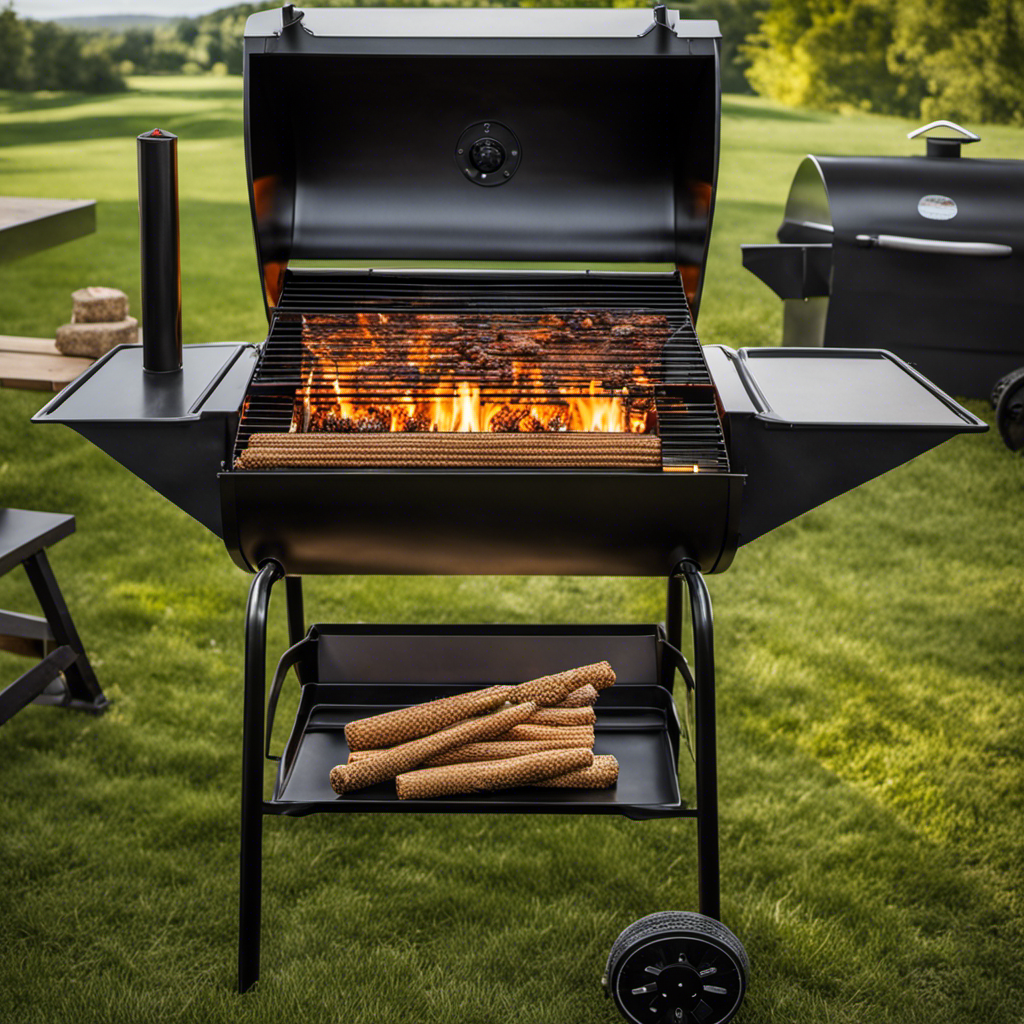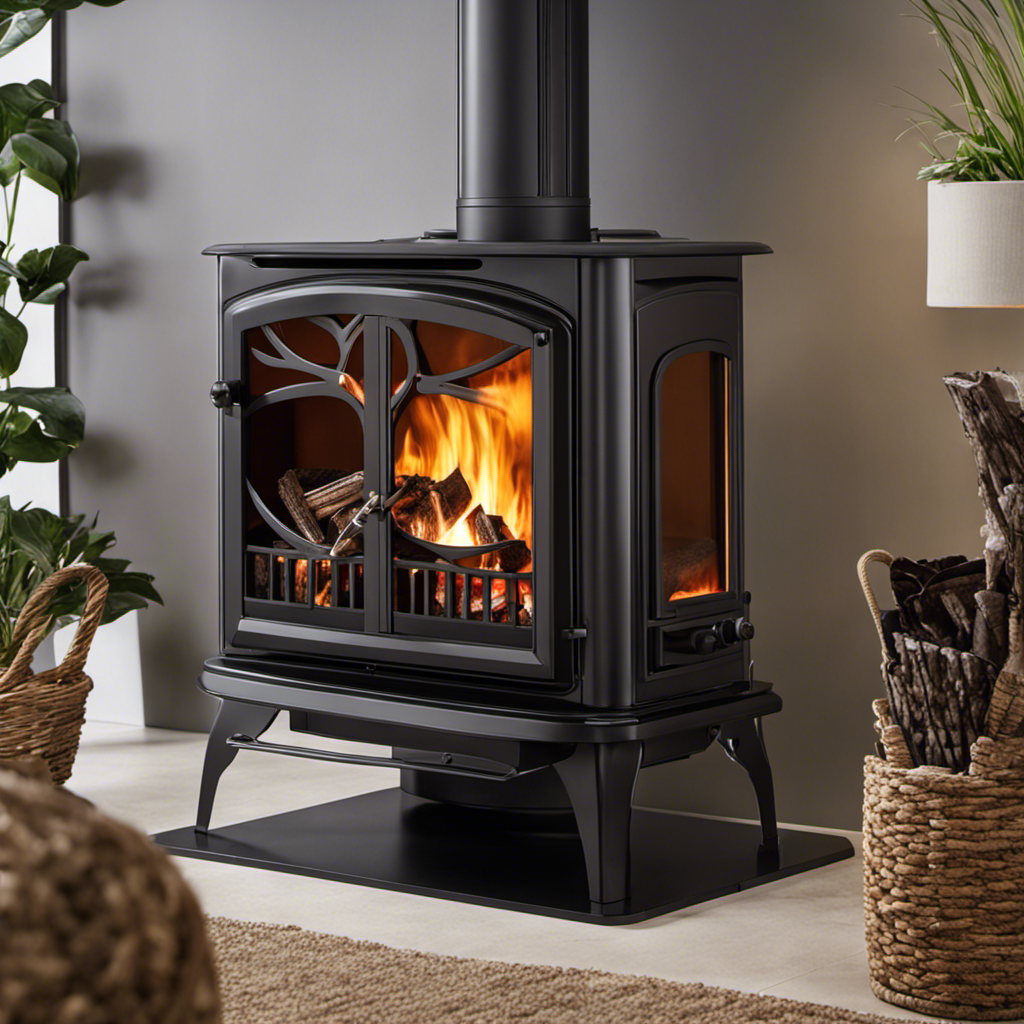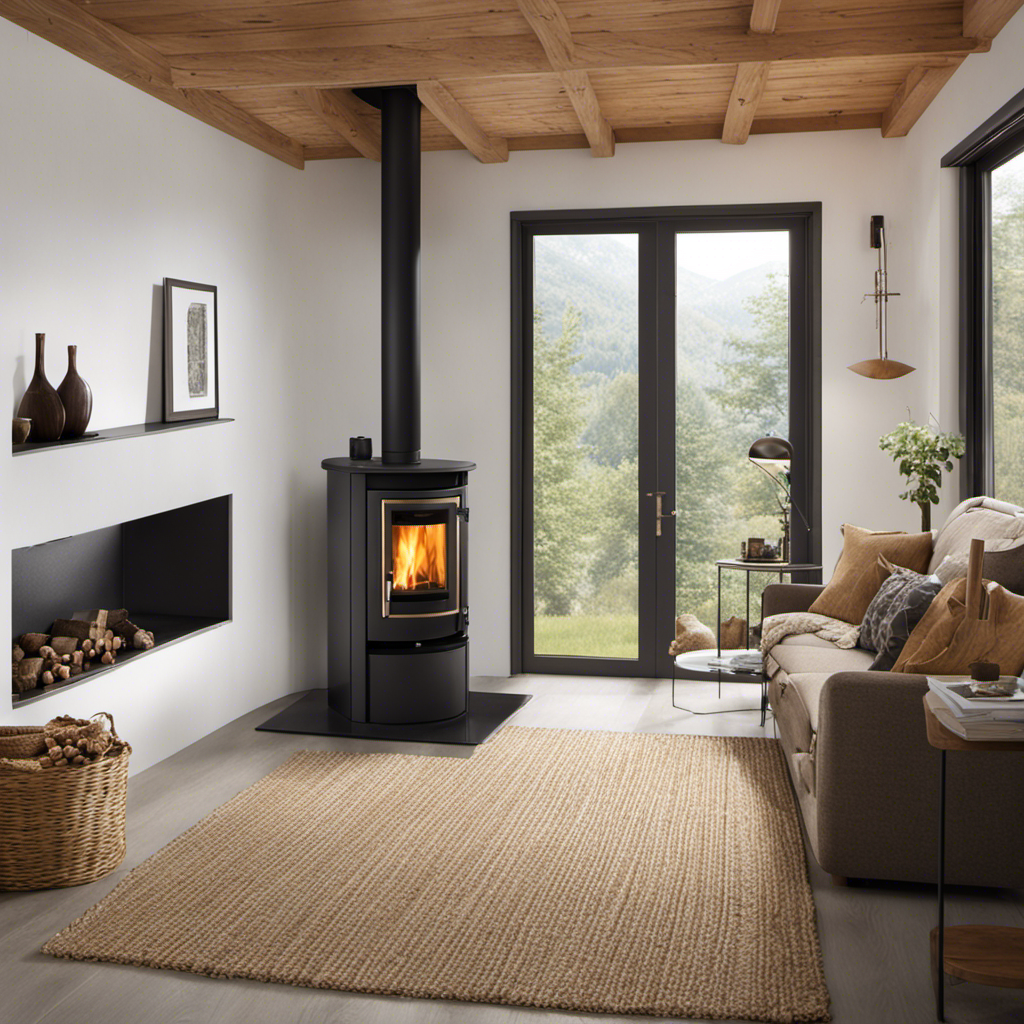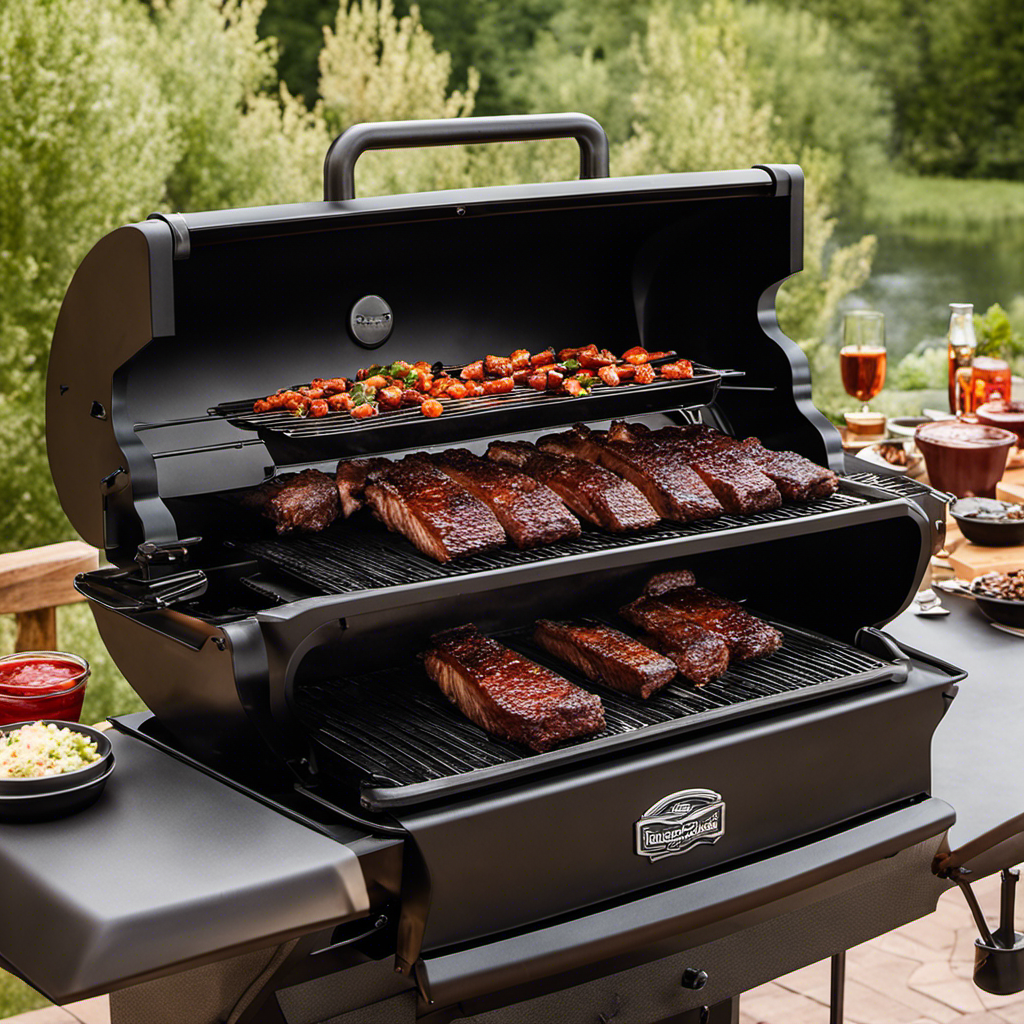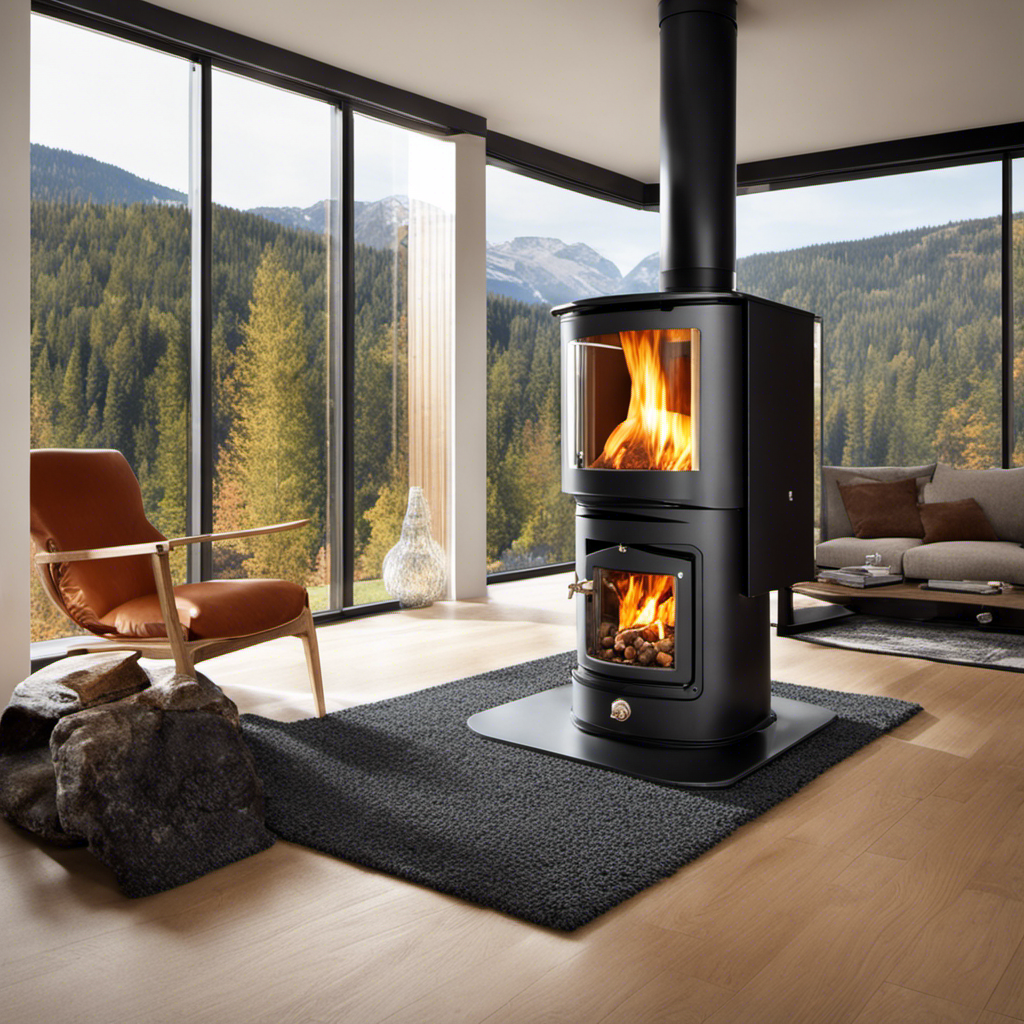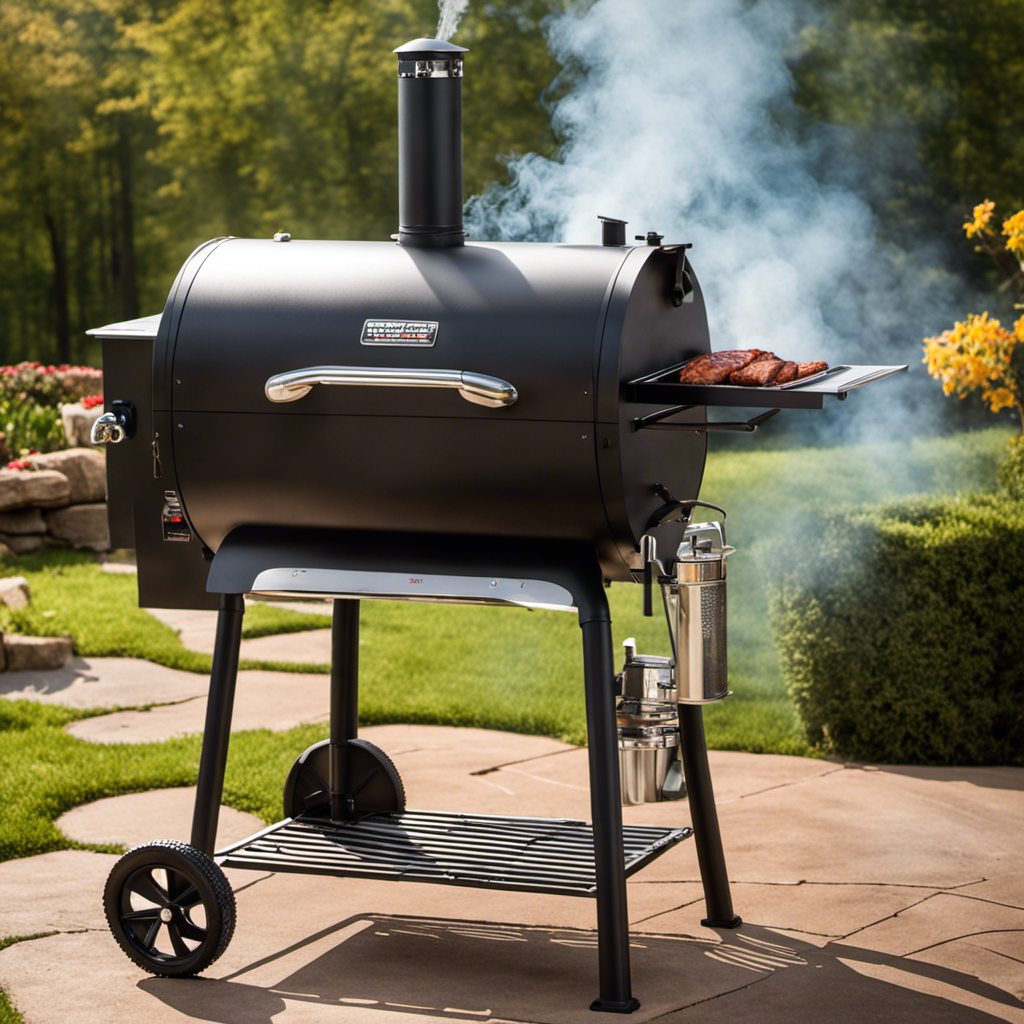Hello, BBQ enthusiasts! Have you ever thought about how a wood pellet grill works? Allow me to explain it to you in detail.
I’m gonna take you on a journey through the inner workings of these bad boys. From the fuel, wood pellets, to the mechanics, temperature control, and even the ignition system – we’ll cover it all.
Get ready to dive into the world of wood pellet grills and unlock the secrets behind that mouthwatering flavor.
Let’s fire it up!
Key Takeaways
- Wood pellet grills use wood pellets as the primary fuel source.
- The combustion process generates heat and smoke for cooking.
- Temperature control mechanism allows precise adjustments for consistent results.
- Regular cleaning of pellet ash and burn pot optimizes efficiency.
The Basics of Wood Pellet Grills
So, you’re interested in learning the basics of how a wood pellet grill works? Well, you’ve come to the right place. Let me walk you through it.
Wood pellet grills are a fantastic option for outdoor cooking enthusiasts who want a convenient and flavorful grilling experience. Understanding the cooking process is key to appreciating the benefits of using a wood pellet grill.
These grills rely on wood pellets as their primary fuel source, which are made from compressed sawdust and provide a rich and smoky flavor to your food. The pellets are fed into a hopper, and an auger delivers them to a fire pot where they are ignited. The heat and smoke created by the burning pellets cook your food to perfection.
Now, let’s move on to understanding the fuel: wood pellets.
Understanding the Fuel: Wood Pellets
To understand how a wood pellet grill operates, you need to be familiar with the fuel it relies on: wood pellets. These small, cylindrical pieces of compressed wood are specifically designed for use in pellet grills, offering a unique combination of convenience, flavor, and environmental sustainability.
Wood pellet composition: Wood pellets are typically made from compacted sawdust and wood shavings. This composition ensures a consistent burn and flavor profile, making them perfect for grilling.
Environmental sustainability: Wood pellets are considered an eco-friendly fuel option. They are made from renewable resources and produce minimal ash and smoke, reducing their impact on the environment.
Flavor enhancement: Wood pellets come in a variety of flavors, such as hickory, mesquite, and applewood. This allows you to add a distinct and delicious smoky flavor to your grilled dishes.
Transitioning into the subsequent section about the mechanics of a wood pellet grill, let’s now explore how these amazing fuel sources are utilized to create mouthwatering meals.
The Mechanics of a Wood Pellet Grill
When it comes to the mechanics of a wood pellet grill, understanding the pellet combustion process is essential.
The combustion process involves the controlled burning of wood pellets to generate heat and create flavorful smoke.
This process is facilitated by a temperature control mechanism that allows for precise adjustments to achieve the desired cooking temperature.
Additionally, the wood pellet fuel source plays a crucial role in the overall performance of the grill, as high-quality pellets with consistent composition ensure efficient combustion and excellent flavor infusion into the food.
Pellet Combustion Process
In order to understand how a wood pellet grill works, you should know that the pellet combustion process is what produces heat and smoke for cooking.
It all starts with the pellets, which are made from compressed wood sawdust. As they are fed into the grill’s firebox, they are ignited by an electric element or a hot rod.
The combustion of the pellets generates heat and smoke, which are then circulated throughout the cooking chamber by a fan. This process not only provides the necessary heat for cooking, but it also infuses the food with a delicious smoky flavor.
To optimize combustion efficiency, it is important to regularly clean out the pellet ash and inspect the burn pot. With a clean burn pot and proper airflow, the grill can achieve maximum efficiency.
Now, let’s move on to the temperature control mechanism, which allows you to have precise control over your cooking temperature.
Temperature Control Mechanism
The temperature control mechanism on a wood pellet grill allows you to easily adjust the cooking temperature to your desired level. By regulating the airflow and temperature, you have full control over the grilling process, ensuring perfectly cooked meals every time.
The airflow control feature allows you to increase or decrease the amount of oxygen that reaches the fire, which directly affects the temperature inside the grill. A simple adjustment of the airflow control knob can either intensify the heat or lower it, depending on your cooking needs.
This precise temperature regulation is what sets wood pellet grills apart from other grilling methods. With the ability to fine-tune the temperature, you can achieve consistent results and cook a wide variety of dishes to perfection.
Now, let’s move on to the next section and explore the wood pellet fuel source.
Wood Pellet Fuel Source
One of the main advantages of using wood pellets as a fuel source is their efficiency in maintaining a consistent temperature for grilling. Wood pellets are made from compressed sawdust, which means they burn cleanly and produce a consistent heat output. Compared to other fuel sources like charcoal or propane, wood pellets provide a more reliable and controlled grilling experience.
The pellets are designed to ignite quickly and generate a steady, even heat that can be easily adjusted to achieve the desired temperature. This level of control allows for precise cooking and ensures that your food is cooked evenly every time.
In the next section, we will explore how the wood pellet grill utilizes this efficient fuel source to control temperature and heat distribution without any complicated steps.
Controlling Temperature and Heat Distribution
To control temperature and evenly distribute heat, a wood pellet grill uses a digital controller and a fan. This ingenious system allows for precise control over the cooking process, ensuring that the food is cooked to perfection every time.
The digital controller monitors the temperature inside the grill and adjusts the speed of the fan accordingly. By increasing or decreasing the airflow, it can regulate the intensity of the fire and maintain a consistent temperature. This level of control is especially important when slow-cooking or smoking meats, as it ensures that the meat is cooked evenly and to the desired level of doneness.
The even heat distribution provided by the fan also helps to prevent hot spots and allows for more consistent cooking results.
Now, let’s delve into the pellet auger and hopper: how they work together to deliver the fuel needed for the grill.
Pellet Auger and Hopper: How They Work Together
Now, let’s explore how the pellet auger and hopper work together to deliver the fuel you need for your cooking.
The pellet hopper is where you store the wood pellets, and its capacity determines how long you can cook without refilling.
The hopper is connected to the pellet auger, which is essentially a screw-like mechanism responsible for feeding the pellets into the fire pot.
The pellet feed rate can be adjusted to control the temperature of the grill. By increasing or decreasing the feed rate, you can achieve the desired level of heat for your cooking.
The pellet auger and hopper work seamlessly to provide a constant supply of fuel, ensuring consistent heat and flavor throughout your grilling experience.
Now, let’s move on to the next section and discuss the ignition system: starting the grill.
The Ignition System: Starting the Grill
The ignition system is responsible for starting the grill and ensuring a seamless cooking experience. Without a properly functioning ignition system, you may encounter issues with lighting your grill or maintaining consistent heat.
Here are three key things to know about the ignition system:
-
Safety first: Always follow proper ignition safety procedures, such as keeping flammable materials away from the grill and ensuring the area is well-ventilated.
-
Troubleshooting tips: If your grill doesn’t ignite, check if the igniter is clean and free from debris. Also, make sure the gas valve is open and the propane tank is not empty.
-
Regular maintenance: Clean the igniter regularly to remove any buildup that may hinder its performance. Additionally, inspect the wiring and connections for any signs of damage or wear.
Now, let’s transition to the importance of airflow and ventilation in achieving optimal grilling results.
The Importance of Airflow and Ventilation
Make sure you understand the importance of airflow and ventilation in order to achieve optimal grilling results.
When it comes to wood pellet grills, airflow optimization is crucial for temperature regulation. The combustion process depends on a consistent supply of oxygen to the fire, and proper ventilation allows for the release of smoke and heat.
By controlling the airflow, you can adjust the temperature inside the grill, giving you more control over the cooking process. Without proper airflow, you might end up with unevenly cooked food or even flare-ups.
So, take the time to understand how your grill’s airflow system works and make adjustments as needed.
Now that we’ve covered the importance of airflow and ventilation, let’s move on to cleaning and maintenance tips for wood pellet grills.
Cleaning and Maintenance Tips for Wood Pellet Grills
When it comes to grilling, keeping your grill clean and well-maintained is essential for optimal performance and longevity.
In this discussion, I will share my knowledge and passion for cleaning techniques that will help you keep your grill in top shape.
Cleaning Techniques for Grills
To keep your grill in optimal condition, it’s important to regularly clean it using techniques specifically designed for grills. Cleaning not only ensures that it looks good, but also helps maintain performance and extend its lifespan.
Here are three effective cleaning techniques for grills:
-
Brushing: Use a grill brush with stiff bristles to scrub away any food residue or grease. Make sure to clean both the grates and the inside of the grill thoroughly.
-
Soaking: Soak the grates in warm, soapy water for a few hours to loosen any stubborn debris. After soaking, scrub them with a brush or sponge to remove any remaining residue.
-
Burn-off: Turn the grill on high heat for about 15 minutes to burn off any remaining food particles. This will help sanitize the grill and eliminate any lingering odors.
By regularly employing these cleaning techniques, you can ensure that your grill remains in top-notch condition. This will allow you to enjoy delicious and perfectly cooked meals for years to come.
Now, let’s move on to the next section about extending the lifespan of your grill.
Extending Grill Lifespan
Now that we’ve discussed cleaning techniques for grills, let’s focus on extending the lifespan of your wood pellet grill. Proper maintenance is key in ensuring your grill lasts for many years to come. By following a few simple techniques, you can keep your grill in top shape and avoid costly repairs or replacements.
| Maintenance Technique | Description | Frequency |
|---|---|---|
| Regular Cleaning | Remove grease and residue from the grill grates, drip tray, and fire pot. | After each use |
| Seasoning | Apply a thin layer of cooking oil to the grates to prevent rust and improve flavor. | Every few months |
| Inspecting Components | Check for any signs of wear or damage to the hopper, auger, and fan. Replace any faulty parts. | Monthly |
By incorporating these maintenance techniques into your routine, you’ll ensure that your wood pellet grill stays in optimal condition. Now, let’s explore how you can enhance the flavor of your grilled dishes through smoking and searing techniques.
Transition: Now that we know how to extend the lifespan of our grill, let’s take a closer look at how we can enhance the flavor of our dishes using smoking and searing techniques.
Enhancing Flavor: Smoking and Searing Techniques
By using a wood pellet grill, you can add a unique and delicious smoky flavor to your food, enhancing its overall taste. The secret lies in the smoke infusion process.
As the wood pellets burn, they release aromatic smoke that envelops your food, infusing it with a rich, smoky essence. This adds depth and complexity to your dishes, taking them to a whole new level of flavor.
But that’s not all. A wood pellet grill also allows you to achieve those coveted sear marks on your food. The direct heat from the grill grates creates a beautiful caramelization on the exterior of your meat, giving it a mouthwatering appearance and an irresistible texture.
What are the mechanisms behind the functionality of a wood pellet grill?
The wood pellet grill operation revolves around a few key mechanisms. First, the pellets are fed into a hopper and transported to the firepot via an auger. Then, a hot rod ignites the pellets, creating heat and smoke. The fan controls airflow to maintain an even temperature for cooking.
What Are the Benefits of Using a Wood Pellet Grill?
A wood pellet grill operation offers numerous benefits, including precise temperature control, versatility in cooking styles, and an environmentally friendly fuel source. The wood pellets impart a rich, smoky flavor to the food, while the convenient operation makes it easy to use for both beginners and seasoned grill masters.
Frequently Asked Questions
How Long Does It Take for a Wood Pellet Grill to Reach the Desired Temperature?
It takes about 10-15 minutes for a wood pellet grill to reach the desired temperature. With precise temperature control, you can easily set and maintain the perfect cooking temperature for your grilling needs.
Can I Use Regular Wood Chips Instead of Wood Pellets in a Wood Pellet Grill?
Yes, you can use regular wood chips in a wood pellet grill, but there are pros and cons. Wood pellets provide consistent heat and flavor, while wood chips may burn faster and produce less smoke.
Are Wood Pellet Grills Suitable for Cooking Large Cuts of Meat, Like Brisket or Whole Chickens?
Yes, wood pellet grills are suitable for cooking large cuts of meat like brisket or whole chickens. The slow and steady cooking techniques of a wood pellet grill result in tender, juicy meat with delicious smoky flavor profiles.
Can I Use My Wood Pellet Grill in Cold Weather or During the Winter?
Using a wood pellet grill for smoking meat in cold weather is definitely possible. Here are some tips for using a wood pellet grill in winter conditions: keep the grill covered when not in use, use insulation blankets, and monitor the temperature closely.
Are Wood Pellet Grills Easy to Clean and Maintain Compared to Other Types of Grills?
Wood pellet grills are easy to clean and maintain compared to other types of grills. Cleaning tips include regularly emptying the ash pan, brushing the grates, and wiping down the exterior. I recommend following a maintenance schedule to keep it in top shape.
Conclusion
In conclusion, I must say that wood pellet grills are truly a game-changer in the world of outdoor cooking. With their efficient mechanics and precise temperature control, they have revolutionized the way we grill.
The tantalizing aroma and mouthwatering flavors they produce are simply unparalleled. It’s like experiencing a culinary masterpiece in your own backyard.
So, if you’re looking to elevate your grilling game and create mouthwatering dishes that will leave your guests in awe, a wood pellet grill is a must-have. Trust me, you won’t be disappointed.

